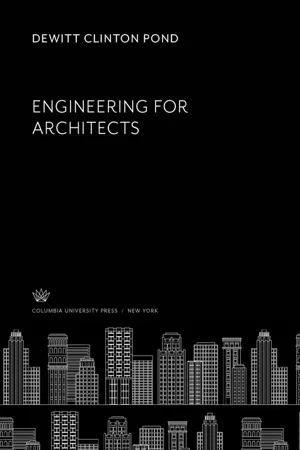
This is a test
- 104 pages
- English
- PDF
- Available on iOS & Android
eBook - PDF
Engineering for Architects
Book details
Table of contents
Citations
About This Book
A handbook with mathematical information to help architects overcome simple engineering problems in the design of floor beams, girders, column sections, grillage beams, and simple roof trusses.
Frequently asked questions
At the moment all of our mobile-responsive ePub books are available to download via the app. Most of our PDFs are also available to download and we're working on making the final remaining ones downloadable now. Learn more here.
Both plans give you full access to the library and all of Perlego’s features. The only differences are the price and subscription period: With the annual plan you’ll save around 30% compared to 12 months on the monthly plan.
We are an online textbook subscription service, where you can get access to an entire online library for less than the price of a single book per month. With over 1 million books across 1000+ topics, we’ve got you covered! Learn more here.
Look out for the read-aloud symbol on your next book to see if you can listen to it. The read-aloud tool reads text aloud for you, highlighting the text as it is being read. You can pause it, speed it up and slow it down. Learn more here.
Yes, you can access Engineering for Architects by Dewitt Clinton Pond in PDF and/or ePUB format, as well as other popular books in Architecture & Architecture General. We have over one million books available in our catalogue for you to explore.
Information
Table of contents
- Preface
- Content
- CHAPTER I. Failure of beams. Definition of “Moment.” Formula for the maximum bending moment caused by a uniform load. The use of handbooks
- CHAPTER II. Wood beams. Moment of Inertia. Safe loads; Floor Construction
- CHAPTER III. Concentrated Loads. Reactions. Points of maximum bending moment, and shear diagrams. Method of finding M, the maximum bending moment. Method of finding the section modulus when M is measured in foot-tons. The design of spandrel beams.
- CHAPTER IV. “Built up” Girders. Depth of girder. Thickness of web plate. Maximum bending moment. Area of flanges. Length of cover plates and bending moment diagram. Stiffeners
- CHAPTER V. Columns. Formulas. Assumed section and safe stress per square inch. Dimensions. Moments of inertia. Radii of gyration. Actual safe working stress. Supporting value of section. Checks
- CHAPTER VI. Grillage beams. Failure by crushing. Assumed number of beams in lower layer. Calculated lengths. Size of concrete footing. Checks. Grillage for outside columns
- CHAPTER VII. Grillage foundations on soil. Size of concrete footing. Length of beams. Maximum bending moment and section modulus of upper beams. Tests for shearing and crushing. Design of lower layer of beams. Footings for corner columns. Cantilever beams
- CHAPTER VIII. Steel Framing Plan. Record of calculations. “Filling-in” beams. Girders. Trial calculations
- CHAPTER IX. Column Schedules. Formulas. Loads. Column sections. Checks. Eccentric loads
- CHAPTER X. Graphical Methods of Indicating Forces. Composition of forces. Resultants and equilibrants. Points of application. Graphical methods applied to simple beams
- CHAPTER XI. Simple Truss Problems. Fan truss. Fink truss. French Truss. Wind load diagram, both ends of truss fixed
- CHAPTER XII. Wind Load Diagram – One end free. Tabulating of stresses. Cantilever Trusses